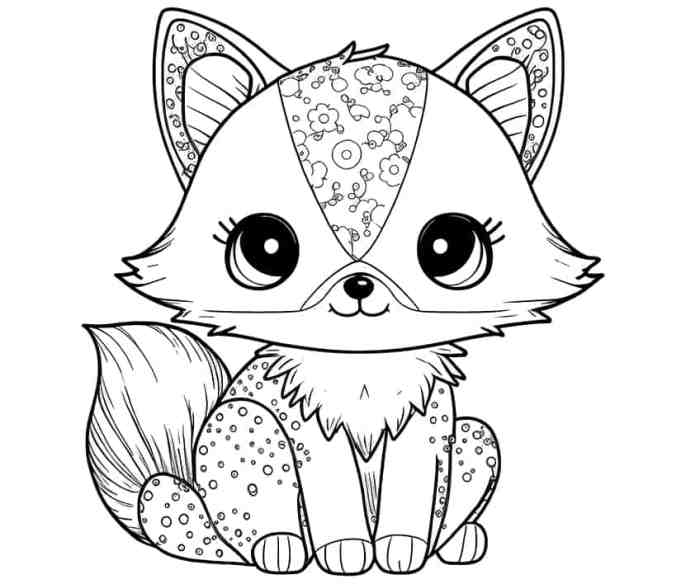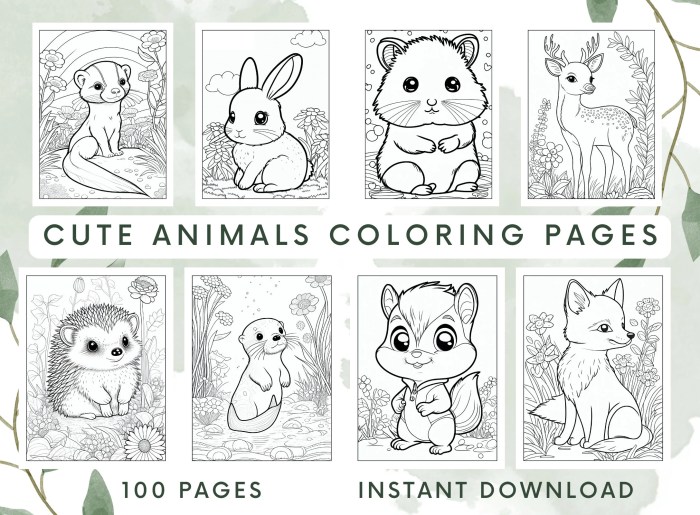The Benefits of Animal Coloring Pictures

Animal coloring pictures to – Animal coloring pictures offer a surprisingly wide range of benefits, extending beyond simple entertainment. They provide a calming activity for adults and a valuable learning tool for children, fostering creativity and skill development in engaging and enjoyable ways. The act of coloring itself, combined with the captivating imagery of animals, creates a unique and beneficial experience.
Stress Reduction Through Coloring, Animal coloring pictures to
Coloring animal pictures can be a powerful tool for stress reduction. The repetitive nature of the activity can induce a meditative state, allowing for a mindful escape from daily pressures. The focus required to stay within the lines and choose colors encourages present moment awareness, diverting attention away from anxieties and worries. This mindful coloring can lower cortisol levels, the hormone associated with stress, promoting relaxation and a sense of calm.
The engaging nature of the animal imagery further enhances this effect, providing a pleasant and visually stimulating experience.
Fine Motor Skill Development in Children
Animal coloring pages offer an excellent opportunity for children to develop and refine their fine motor skills. The act of holding a crayon or pencil, controlling its pressure, and maneuvering it within the lines requires precision and coordination. This repetitive practice strengthens hand muscles, improves dexterity, and enhances hand-eye coordination. As children progress, they can tackle increasingly intricate designs, further challenging and improving their fine motor control.
For example, coloring the intricate patterns on a tiger’s stripes or the delicate features of a hummingbird’s wings provides progressively more challenging exercises in fine motor control.
Animal Coloring as an Educational Tool
Animal coloring pages can serve as a valuable educational tool, making learning about animals fun and engaging. Children can learn to identify different animals, their characteristics, and their habitats through the act of coloring. For instance, coloring a picture of a polar bear might spark a conversation about its arctic environment and its adaptations for survival in cold climates.
Similarly, coloring a rainforest scene populated with various animals introduces children to biodiversity and different ecosystems. The visual engagement enhances memorization and understanding, transforming a learning experience into an enjoyable activity.
Hey there, matey! Animal coloring pictures to brighten your day are super fun, right? If you’re looking for a whole bunch of amazing creatures to color, you absolutely HAVE to check out the animal kingdom coloring book ; it’s packed with awesome animals! From playful monkeys to majestic lions, it’s the perfect place to find more animal coloring pictures to unleash your inner artist!
Cognitive Benefits of Animal Coloring
Coloring animal pictures offers several cognitive benefits. It improves focus and concentration, requiring sustained attention to detail. The creative process of choosing colors and patterns stimulates imagination and self-expression. Furthermore, coloring can enhance problem-solving skills as children navigate complex designs and decide on color palettes. The completion of a coloring page provides a sense of accomplishment, boosting self-esteem and confidence.
These cognitive benefits are particularly valuable for children’s development, laying the foundation for future learning and problem-solving abilities. For example, choosing appropriate colors for a lion’s mane or deciding how to shade a giraffe’s spots requires decision-making and problem-solving skills.
Creating and Designing Animal Coloring Pages: Animal Coloring Pictures To

Designing and creating animal coloring pages is a rewarding process that blends artistic expression with the joy of creative play. Whether for personal use or for wider distribution, careful consideration of design elements can greatly enhance the appeal and enjoyment of the final product. This section explores the process of creating both traditional and digital animal coloring pages, highlighting techniques for incorporating visual interest and engaging details.
A Simple Panda Coloring Page Design
This design features a playful panda sitting amidst bamboo stalks. The panda is depicted in a relaxed posture, perhaps leaning against a stalk, with one paw playfully raised. Its fur is shown with simple, rounded shapes, leaving ample space for coloring. The bamboo stalks are rendered with varying thicknesses and slightly curved lines to add a sense of natural movement.
Simple, rounded leaves sprout from the stalks, adding a touch of greenery. The overall style is simple and child-friendly, with clear Artikels and minimal detail to make coloring accessible for a range of ages and skill levels. The panda’s face features large, expressive eyes, a small nose, and a gentle smile. The background is left intentionally blank to allow for creative freedom in coloring.
Creating a Digital Animal Coloring Page
Creating a digital coloring page involves several steps using graphics software such as Adobe Photoshop or GIMP.
- Sketching: Begin with a rough sketch of the animal and its surroundings. This initial sketch can be done freehand with a digital pen tool or by importing a scanned hand-drawn sketch. The focus here is on capturing the basic shapes and proportions.
- Line Art: Refine the sketch into clean, distinct lines. Use a vector-based program or a high-resolution raster program for crisp, scalable lines. This step involves tracing over the sketch, creating smooth, continuous lines that define the animal’s features and Artikels.
- Color Palette Selection: Choose a color palette that enhances the animal’s features without overwhelming the design. Consider the animal’s natural colors and experiment with variations to create a visually appealing effect. A limited color palette is often preferable for coloring pages to avoid visual clutter.
- Adding Details: Incorporate subtle details like fur texture (indicated by short, light strokes), or patterns in the background. These details add visual interest without complicating the coloring process excessively.
- Cleanup and Export: Clean up any stray lines or imperfections. Export the final design as a high-resolution image file, such as a PNG or JPG, suitable for printing or online use.
Traditional vs. Digital Coloring Page Creation
Traditional methods, involving pen and paper, offer a more immediate and tactile experience. The process is less precise but allows for spontaneous adjustments and unique imperfections. Digital creation, using software, provides greater control, precision, and the ability to easily make corrections and revisions. Digital methods also allow for easy reproduction and distribution, and offer the advantage of incorporating more complex details and textures.
The choice between traditional and digital methods often depends on personal preference, artistic style, and intended use.
Incorporating Textures and Patterns
Textures and patterns can add significant visual richness to animal coloring pages. For example, a zebra’s stripes can be represented by varying line thicknesses or by incorporating subtle shading to suggest depth and form. A lion’s mane can be depicted with short, overlapping strokes to simulate fur. Backgrounds can feature textured elements like grass, leaves, or water, adding depth and context.
These textures can be achieved digitally through brushes, filters, or by using scanned textures, or traditionally using different types of pens or pencils to create variations in line weight and shading. Remember to maintain a balance between detail and clarity to ensure the coloring page remains enjoyable and accessible.
Animal Coloring Pages and Educational Resources

Animal coloring pages offer a surprisingly versatile tool for educators, seamlessly blending creativity with learning across various subjects. Their engaging nature makes them ideal for capturing children’s attention and fostering a positive learning environment, while simultaneously providing opportunities for skill development and knowledge acquisition. The simple act of coloring can enhance fine motor skills, hand-eye coordination, and focus, while the subject matter – animals – opens doors to exploring broader scientific and environmental concepts.Animal coloring pages are effectively utilized within several established educational resources and methodologies.
They are frequently integrated into early childhood education programs as a fun and engaging way to introduce new vocabulary related to animals, their habitats, and characteristics. Furthermore, they can support the development of pre-writing skills and color recognition. In older age groups, more complex coloring pages, perhaps those depicting intricate animal anatomy or diverse ecosystems, can be used to reinforce concepts taught in science and social studies classes.
Examples of Animal Coloring Pages in Classroom Activities
Animal coloring pages can be incorporated into various classroom activities to enhance learning. For instance, after a lesson on animal habitats, students could color pictures of animals in their respective environments – a polar bear on an ice floe, a monkey swinging through a jungle, or a giraffe on the African savanna. This reinforces the learned concepts visually and provides a creative outlet for expressing understanding.
Similarly, a lesson on animal diets could be followed by coloring pages depicting animals eating their typical food sources. Following a story about a particular animal, coloring a picture of that animal can solidify the narrative in the child’s mind. Teachers could also utilize coloring pages as part of a larger project, such as creating a classroom animal encyclopedia or designing a zoo exhibit.
This encourages collaborative learning and the development of broader presentation skills.
Websites and Platforms for Printable Animal Coloring Pages
Many websites and platforms offer free or printable animal coloring pages suitable for educational use. These resources often categorize pages by animal type, habitat, or difficulty level, making it easier for educators to find appropriate materials. Educational websites specifically designed for teachers frequently include sections dedicated to printable resources, often incorporating coloring pages as part of their broader curriculum materials.
Many general websites dedicated to printable coloring pages also feature a wide selection of animal-themed options, offering variety and choice. Finally, teachers can also leverage commercially available workbooks and activity books that include animal coloring pages, often paired with accompanying educational exercises.
Utilizing Animal Coloring Pages for Teaching about Animal Habitats and Conservation
Animal coloring pages provide an effective medium for teaching children about animal habitats and the importance of conservation. By coloring animals within their natural environments, children develop a visual understanding of the interconnectedness of species and their surroundings. Educators can use this as a springboard for discussions about habitat destruction, pollution, and climate change, highlighting the impact of human actions on animal populations.
Moreover, coloring pages can be used to illustrate the diversity of animal life and the importance of protecting endangered species. Teachers might incorporate coloring pages into projects where students research specific endangered animals, creating informative posters or presentations that combine art with scientific facts. This approach fosters a sense of responsibility and encourages children to become advocates for animal welfare and environmental protection.
